MassSpectator
|
| |
Introduction
|
 |
An automated data analysis method was required for rapid and
repeatable processing of mass spectral data containing hundreds
of peaks.
Our suite of complementary algorithms works without any user
input, to save operator time and to eliminate operator bias.
This second criterion is crucial to NIST’s goal of creating
a synthetic polymer Standard Reference Material™ for mass
spectral intensity calibration.
|
| |
Experimental Approach
|
 |
A novel non-linear programming optimization algorithm was
developed at NIST.
Given a data set of N points we find a collection of
strategic points, n, and the unique optimal piece-wise
linear function passing through the x coordinate of each
strategic point.
n defines a new function from which the peak maxima and
limits can be easily determined.
The original data is then integrated under each peak maximum
between the two adjacent minima using a simple trapezoidal rule.
|
| |
Approach
|
 |
Algorithm
Consider a hypothetical three-peak scenario with added Gaussian
random noise.
|
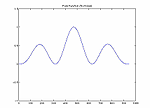 |
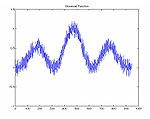 |
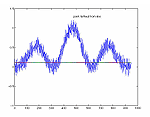 |
 |
| A) Original data |
B) With added noise |
C) Take 1st & last points
|
D) Find point greatest distance normal
to line |
|
| |
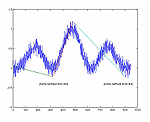 |
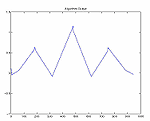 |
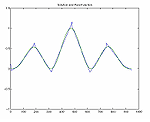 |
Results:
Analytical Areas (exact values)
100. (left peak)
175. (middle peak)
100. (right peak)
Algorithm Calculated Areas
101.609 (area +1.6%)
178.591 (area +2.0%)
102.873 (area +2.9%) |
E) Iterate to sensitivity limit
|
F) Output peak positions and
widths
|
F) Comparison to original data
|
|
| |
Results
|
 |
| |
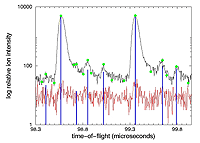 Consider
the polystyrene (SRM 2888) MALDI-TOF mass spectrum given below
(black), the matrix-only background spectrum (red), the resultant
strategic points (green) defining peak beginning, center, and
end, and the relative peak areas (blue). Consider
the polystyrene (SRM 2888) MALDI-TOF mass spectrum given below
(black), the matrix-only background spectrum (red), the resultant
strategic points (green) defining peak beginning, center, and
end, and the relative peak areas (blue).
This was done without operator intervention of any sort.
|
| |
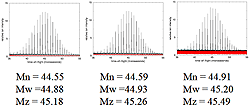 Consider
the following polyethylene glycol mass spectrum with added random
noise. Calculation of moments of the distribution is little
affected by noise. Consider
the following polyethylene glycol mass spectrum with added random
noise. Calculation of moments of the distribution is little
affected by noise.
|
| |
MassSpectator Publicly-Accessible On-line at: www.nist.gov/maldi
|
 |
| |
Contributors
|
 |
Polymers Division:
William E. Wallace
Charles M. Guttman |
| |
Mathematical and Computational Sciences Division:
Anthony J. Kearsley
Peter M. Ketcham |
| |
| |
| |
| |
| |
| |
| |
| |












